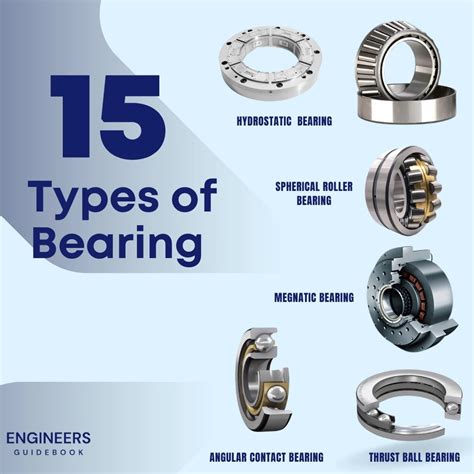Industrial Bearings: A Comprehensive Guide to Their Types, Applications, and Maintenance
Industrial bearings are critical components in various machinery and equipment, enabling smooth rotation, reducing friction, and increasing efficiency. This comprehensive article delves into the world of industrial bearings, providing an in-depth understanding of their types, applications, and essential maintenance practices.
Types of Industrial Bearings
Industrial bearings come in various types, each designed for specific applications and requirements. Here are some common types:
| Type |
Description |
Applications |
| Ball Bearings |
Use rolling balls to support loads |
Low friction, high speeds |
| Roller Bearings |
Use cylindrical or tapered rollers for load support |
Heavy loads, high speeds |
| Needle Bearings |
Thin, needle-shaped rollers |
Compact spaces, high loads |
| Thrust Bearings |
Designed to carry axial loads |
Vertical shafts, pumps |
| Linear Bearings |
Recirculating ball or roller bearings for linear motion |
Conveyors, robotics |
Applications of Industrial Bearings
Industrial bearings find applications across a wide spectrum of industries, including:

-
Automotive: Engines, transmissions, wheels
-
Aerospace: Aircraft engines, landing gear
-
Mining: Conveyor belts, heavy machinery
-
Manufacturing: Precision machinery, robotics
-
Medical Equipment: Surgical tables, imaging devices
Importance of Industrial Bearing Maintenance
Proper maintenance of industrial bearings is crucial to ensure their longevity, prevent premature failure, and maximize equipment performance. Key maintenance practices include:
-
Lubrication: Regular lubrication reduces friction and extends bearing life.
-
Condition Monitoring: Monitoring temperature, vibration, and noise levels can detect potential problems early.
-
Inspection: Visual inspections identify signs of wear or damage.
-
Replacement: Replacing worn or damaged bearings is essential to prevent catastrophic failures.
Effective Strategies for Industrial Bearing Maintenance
To ensure effective maintenance of industrial bearings, consider the following strategies:

-
Preventive Maintenance: Regular inspections, lubrication, and condition monitoring to prevent failures.
-
Reliability-Centered Maintenance: Focusing on critical bearings that impact equipment availability.
-
Condition-Based Maintenance: Monitoring bearing health and replacing them only when necessary.
-
Root Cause Analysis: Identifying and addressing the underlying causes of bearing failures.
Tips and Tricks for Industrial Bearing Maintenance
Here are some useful tips and tricks for effective industrial bearing maintenance:

- Use high-quality bearings from reputable manufacturers.
- Lubricate bearings with the correct type and frequency.
- Monitor bearing temperature regularly for signs of overheating.
- Use vibration analysis to detect potential problems early.
- Train maintenance personnel on proper bearing handling and installation techniques.
Step-by-Step Approach to Industrial Bearing Replacement
Replacing industrial bearings requires precision and proper procedures:
-
Safety First: Ensure machinery is powered down and secured.
-
Inspection: Examine the bearing for damage or wear.
-
Removal: Use appropriate tools to remove the old bearing.
-
Cleaning: Clean the bearing housing and shaft before installing a new bearing.
-
Installation: Lubricate and place the new bearing in the housing.
-
Tightening: Secure the bearing with proper tightening torque.
-
Testing: Run the machinery to ensure proper bearing operation.
Why Industrial Bearing Matters
Industrial bearings play a vital role in various industries, impacting:
-
Equipment Performance: Smooth rotation and reduced friction enhance machinery efficiency.
-
Cost Reduction: Proper maintenance prevents premature bearing failure and costly replacements.
-
Safety: Reliable bearings prevent accidents caused by equipment failure.
-
Uptime: Reduced maintenance intervals increase machine uptime and productivity.
Benefits of Industrial Bearing Maintenance
Regular maintenance of industrial bearings brings numerous benefits:
-
Extended Bearing Life: Lubrication and monitoring reduce wear and tear, extending bearing longevity.
-
Increased Equipment Reliability: Proactive maintenance minimizes the risk of catastrophic failures.
-
Improved Safety: Well-maintained bearings ensure safe equipment operation.
-
Reduced Production Losses: Timely replacements prevent unplanned downtime and production losses.
Pros and Cons of Different Bearing Types
Ball Bearings:
-
Pros: Low friction, high speeds
-
Cons: Limited load capacity
Roller Bearings:
-
Pros: High load capacity, durability
-
Cons: Higher friction, slower speeds
Needle Bearings:
-
Pros: Compact, high load capacity
-
Cons: Susceptible to misalignment
Thrust Bearings:
-
Pros: Designed for axial loads
-
Cons: Limited radial load capacity
True Stories of Industrial Bearing Failure
Here are three humorous stories about industrial bearing failures that highlight the importance of proper maintenance:
The Case of the "Squealing Machine": A manufacturing plant experienced a mysterious squealing noise from one of their machines. After days of investigation, it was discovered that the culprit was a worn-out ball bearing. The bearing had seized, causing the shaft to rub against the housing, producing the deafening squeal.
The Curse of the "Rumbling Conveyor": A mining operation suffered from a persistent rumbling sound on its conveyor belt. Despite multiple inspections, the source of the noise remained elusive. Eventually, a technician noticed a faulty roller bearing that was causing the belt to vibrate. Replacing the bearing silenced the rumble, much to the relief of the maintenance team.

The Costly Mistake of the "Overlooked Bearing": A hospital invested in a state-of-the-art surgical table. However, after only a few months of operation, the table started experiencing erratic movements and strange noises. Upon inspection, it was discovered that a single thrust bearing had been overlooked during a routine maintenance checkup. The neglected bearing had caused the table's precision components to fail, resulting in a costly repair.
Lessons Learned from Industrial Bearing Failures
These stories illustrate the importance of proper industrial bearing maintenance:
- Regularly lubricate and monitor bearings to prevent premature failure.
- Conduct thorough inspections to identify potential problems early.
- Train maintenance personnel on proper bearing handling and installation techniques.
- Address the root causes of bearing failures to prevent recurrence.
Conclusion
Industrial bearings are essential components in modern machinery, contributing to efficiency, reliability, and safety. Understanding their different types, applications, and maintenance practices is crucial for optimal equipment performance and cost-effective operations. By implementing effective strategies, following tips and tricks, and addressing bearing failures promptly, industries can ensure the smooth operation of their machinery, minimize downtime, and achieve maximum productivity.

